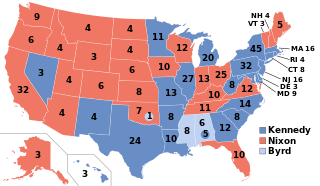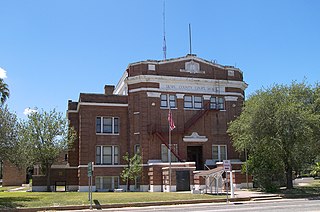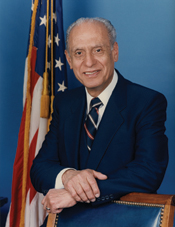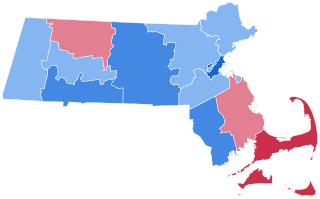
The 1960 United States presidential election was the 44th quadrennial presidential election. It was held on Tuesday, November 8, 1960. In a closely contested election, Democratic Senator John F. Kennedy defeated the incumbent Republican Vice President Richard Nixon. This was the first election in which 50 states participated, marking the first participation of Alaska and Hawaii, and the last in which the District of Columbia did not. This made it the only presidential election where the threshold for victory was 269 electoral votes. It was also the first election in which an incumbent president—in this case, Dwight D. Eisenhower—was ineligible to run for a third term because of the term limits established by the 22nd Amendment.

The 1968 United States presidential election was the 46th quadrennial presidential election, held on Tuesday, November 5, 1968. The Republican nominee, former vice president Richard Nixon, defeated both the Democratic nominee, incumbent vice president Hubert Humphrey, and the American Independent Party nominee, former Alabama governor George Wallace. This was the last election until 1988 in which the incumbent president was not on the ballot. This is the most recent election where a third-party candidate won a state.

Duval County is a county located in the U.S. state of Texas. As of the 2020 census, its population was 9,831. The county seat is San Diego. The county was founded in 1858 and later organized in 1876. It is named for Burr H. Duval, a soldier in the Texas Revolution who died in the Goliad Massacre.

The 1960 Democratic National Convention was held in Los Angeles, California, on July 11–15, 1960. It nominated Senator John F. Kennedy of Massachusetts for president and Senate Majority Leader Lyndon B. Johnson of Texas for vice president.

Héctor Pérez García was a Mexican-American physician, surgeon, World War II veteran, civil rights advocate, and founder of the American GI Forum (AGIF). As a result of the national prominence he earned through his work on behalf of Hispanic Americans, he was instrumental in the appointment of Vicente T. Ximenes, a Mexican American and AGIF charter member, to the Equal Employment Opportunity Commission in 1966.

The Mexican American Political Association (MAPA) is an organization based in California that promotes the interests of Mexican-Americans, Mexicans, Latinos, Chicanos, Hispanics, and Latino economic refugees in the United States. Founded in 1960, their goal was to further incorporate Mexican-Americans into American politics and society through increased voter turnout and election to public office. MAPA, alongside the rest of the member organizations of the Political Association of Spanish-Speaking Organizations (PASSO), developed from the Viva Kennedy Campaign to elect John F. Kennedy president.
Latino Americans have received a growing share of the national vote in the United States due to their increasing population. As of the 2020 U.S. Census, 62.1 million Latinos live in the United States, representing 18.9% of the total U.S. population. This is a 23% increase since 2010. This racial/ethnic group is the second largest after non-Hispanic whites in the U.S. In 2020, the states with the highest Hispanic or Latino populations were; Arizona, California, Florida, Illinois, Nevada, New Jersey, New Mexico, New York, and Texas. According to the Brookings Institution, Latinos will become the nation's largest minority by 2045 and the deciding population in future elections. With the help of laws and court case wins, Latinos have been able to receive the help needed to participate in American Politics. According to data provided by The Collaborative Multiracial Post-Election Survey (CMPS), 72% of Latinos believe that it is very/somewhat important to get their voice heard by voting. They have traditionally been a key Democratic Party constituency, but more recently have begun to split between the Democratic and Republican Party. Since the Latino population is large and diverse, a lot of political differences exist between gender, national origin, and generational groups.

The 1968 United States presidential election in New Mexico took place on November 5, 1968. All fifty states and The District of Columbia, were part of the 1968 United States presidential election. State voters chose four electors to represent them in the Electoral College, who voted for president and vice president.

The 1960 United States presidential election in Massachusetts took place on November 8, 1960, as part of the 1960 United States presidential election, which was held throughout all 50 states. Voters chose 16 representatives, or electors to the Electoral College, who voted for president and vice president.

The 1960 United States presidential election in New Jersey took place on November 8, 1960. All 50 states were part of the 1960 United States presidential election. Voters chose 16 electors to the Electoral College, which selected the president and vice president.

The 1960 United States presidential election in New Hampshire took place on November 8, 1960, as part of the 1960 United States presidential election, which was held throughout all 50 states. Voters chose four representatives, or electors to the Electoral College, who voted for president and vice president.
The Political Association of Spanish-Speaking Organizations (PASSO) was formed as an outgrowth of the success of the Viva Kennedy Clubs in the 1960 United States Presidential Election. PASSO, which comprised several Mexican-American activist groups, fought to increase Mexican-American participation in electoral politics and campaigned for candidates, generally of Mexican descent, who supported desegregated education, protection from discrimination and federal government jobs for Mexican Americans. Later, the group became involved in farm labor disputes and was ultimately disbanded.

The 1972 United States presidential election in Texas was held on November 7, 1972, as part of the 1972 United States presidential election. Incumbent Republican President Richard Nixon overwhelmingly won the state of Texas with 66.20% of the vote, to the Democratic Party candidate George McGovern's 33.24%, thus giving him the state's 26 electoral votes. This result made Texas 9.8% more Republican than the nation-at-large. This was the first time a Republican won the state of Texas since Texas-born Dwight D. Eisenhower won it in 1956, even as Democrat Dolph Briscoe won the gubernatorial election on the same Ballot.

The 1960 United States presidential election in Texas was held on November 8, 1960, as part of the 1960 United States presidential election. The Democratic Party candidate John F. Kennedy, narrowly won the state of Texas with 50.52 percent of the vote to the Republican candidate Vice President Richard Nixon's 48.52%, a margin of two percent, giving him the state's 24 electoral votes. Despite the presence of U.S. Senator Lyndon B. Johnson on the Democratic ticket, the result made Texas the tenth closest state in the election. Nixon's strong performance in the Dallas–Fort Worth Metroplex, Harris County, the Panhandle, and the Hill Country kept the race close.

The 1960 presidential campaign of John F. Kennedy, then junior United States senator from Massachusetts, was formally launched on January 2, 1960, as Senator Kennedy announced his intention to seek the Democratic Party nomination for the presidency of the United States in the 1960 presidential election.

The 1960 United States presidential election in Arizona took place on November 8, 1960, as part of the 1960 United States presidential election. State voters chose four representatives, or electors, to the Electoral College, who voted for president and vice president.

The 1960 United States presidential election in Iowa took place on November 8, 1960, as part of the 1960 United States presidential election. Voters chose ten representatives, or electors, to the Electoral College, who voted for president and vice president.

The 1960 United States presidential election in South Dakota took place on November 8, 1960, as part of the 1960 United States presidential election. Voters chose four representatives, or electors, to the Electoral College, who voted for president and vice president.

The 1960 United States presidential election in Louisiana took place on November 8, 1960, as part of the 1960 United States presidential election. State voters chose ten representatives, or electors, to the Electoral College, who voted for president and vice president.

Adam Perez Diaz was the first Hispanic elected to the Phoenix City Council and also the first Hispanic to serve as Phoenix's Vice-Mayor. Diaz was appointed to the National Council on Aging by President Bill Clinton. Díaz was among the first seven recipients of the Profiles of Success Hispanic Leadership Award's in the Hall of Fame category.

















